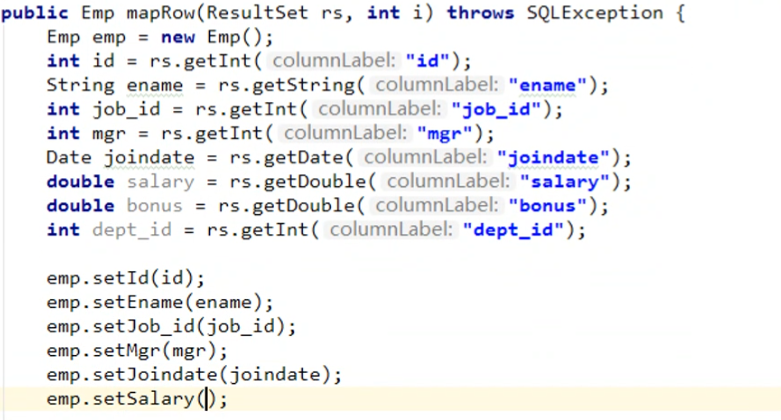Druid:
数据库连接池实现技术,由阿里巴巴提供的
1. 步骤:
1. 导入jar包 druid-1.0.9.jar
2. 定义配置文件:
* 是properties形式的
* 可以叫任意名称,可以放在任意目录下
3. 加载配置文件。Properties
4. 获取数据库连接池对象:通过工厂来来获取 DruidDataSourceFactory
5. 获取连接:getConnection
//3.加载配置文件
Properties pro = new Properties();
InputStream is = DruidDemo.class.getClassLoader().getResourceAsStream("druid.properties");
pro.load(is);
//4.获取连接池对象
DataSource ds = DruidDataSourceFactory.createDataSource(pro);
//5.获取连接
Connection conn = ds.getConnection();2. 定义工具类
1. 定义一个类 JDBCUtils
2. 提供静态代码块加载配置文件,初始化连接池对象
3. 提供方法
1. 获取连接方法:通过数据库连接池获取连接
2. 释放资源
3. 获取连接池的方法
JDBCUtils工具类代码书写:
public class JDBCUtils {
//1.定义成员变量 DataSource
private static DataSource ds ;
static{
try {
//1.加载配置文件
Properties pro = new Properties();
pro.load(JDBCUtils.class.getClassLoader().getResourceAsStream("druid.properties"));
//2.获取DataSource
ds = DruidDataSourceFactory.createDataSource(pro);
} catch (IOException e) {
e.printStackTrace();
} catch (Exception e) {
e.printStackTrace();
}
}
/**
* 获取连接
*/
public static Connection getConnection() throws SQLException {
return ds.getConnection();
}
/**
* 释放资源
*/
public static void close(Statement stmt,Connection conn){
/* if(stmt != null){
try {
stmt.close();
} catch (SQLException e) {
e.printStackTrace();
}
}
if(conn != null){
try {
conn.close();//归还连接
} catch (SQLException e) {
e.printStackTrace();
}
}*/
close(null,stmt,conn);
}
}
/**
* 获取连接池方法
*/
public static DataSource getDataSource(){
return ds;
}
}测试代码:
public class DruidDemo2 {
public static void main(String[] args) {
try {
Connection coon = JDBCutils.getConnection();
String sql = "insert into account values(null,?,?)";
PreparedStatement pstmt = coon.prepareStatement(sql);
pstmt.setString(1,"给第一个字符串类型的?赋值");
pstmt.setDouble(2,3000);
int count = pstmt.executeUpdate();
System.out.println(count);
} catch (SQLException throwables) {
throwables.printStackTrace();
}finally {
JDBCutils.close(pstmt,coon);
}
}
}
Spring JDBC
* Spring框架对JDBC的简单封装。提供了一个JDBCTemplate对象简化JDBC的开发
* 步骤:
1. 导入jar包
2. 创建JdbcTemplate对象。依赖于数据源DataSource
* JdbcTemplate template = new JdbcTemplate(ds);
3. 调用JdbcTemplate的方法来完成CRUD的操作
* update():执行DML语句。增、删、改语句
* queryForMap():查询结果将结果集封装为map集合,将列名作为key,将值作为value 将这条记录封装为一个map集合
* 注意:这个方法查询的结果集长度只能是1
* queryForList():查询结果将结果集封装为list集合
* 注意:将每一条记录封装为一个Map集合,再将Map集合装载到List集合中
* query():查询结果,将结果封装为JavaBean对象
* query的参数:RowMapper
* 一般我们使用BeanPropertyRowMapper实现类。可以完成数据到JavaBean的自动封装
* new BeanPropertyRowMapper<类型>(类型.class)
* queryForObject:查询结果,将结果封装为对象
* 一般用于聚合函数的查询
使用JdbcTemplate的效果
public class JdbcTemplateDemo1 {
public static void main(String[] args) {
JdbcTemplate template = new JdbcTemplate(JDBCutils.getDataSource);
String sql = "update account set balance = 5000 where id = ?";
int update = template.update(sql,3);
System.out.println(update);
}
}4. 练习:
* 需求:
1. 修改1号数据的 salary 为 10000
@Test
public void test1(){
//2. 定义sql
String sql = "update emp set salary = 10000 where id = 1001";
//3. 执行sql
int count = template.update(sql);
System.out.println(count);
}2. 添加一条记录
private JdbcTemplate template = new JdbcTemplate(JDBCUtils.getDataSource());
@Test
public void test2(){
String sql = "insert into emp(id,ename,dept_id) values(?,?,?)";
int count = template.update(sql, 1015, "郭靖", 10);
System.out.println(count);
}3. 删除刚才添加的记录
@Test
public void test3(){
String sql = "delete from emp where id = ?";
int count = template.update(sql, 1015);
System.out.println(count);
}4. 查询id为1的记录,将其封装为Map集合
注意:这个方法查询的结果集长度只能是1
@Test
public void test4(){
String sql = "select * from emp where id = ? or id = ?";
Map<String, Object> map = template.queryForMap(sql, 1001,1002);
System.out.println(map);
//{id=1001, ename=孙悟空, job_id=4, mgr=1004, joindate=2000-12-17, salary=10000.00, bonus=null, dept_id=20}
}5. 查询所有记录,将其封装为List
@Test
public void test5(){
String sql = "select * from emp";
List<Map<String, Object>> list = template.queryForList(sql);
for (Map<String, Object> stringObjectMap : list) {
System.out.println(stringObjectMap);
}
}6. 查询所有记录,将其封装为Emp对象的List集合

@Test
public void test5(){
String sql = "select * from emp";
//指定泛型和字节码类型
List<Map<String, Object>> list = template.queryForList(sql);
for (Map<String, Object> stringObjectMap : list) {
System.out.println(stringObjectMap);
}
}7. 查询总记录数
@Test
public void test7(){
String sql = "select count(id) from emp";
Long total = template.queryForObject(sql, Long.class);
System.out.println(total);
}







 本文介绍了如何使用阿里巴巴的Druid数据库连接池,包括导入jar包、配置文件的加载、获取连接池对象以及获取数据库连接。同时,展示了JDBCUtils工具类的编写,用于简化数据库操作。此外,还详细阐述了SpringJDBC的JdbcTemplate如何简化CRUD操作,如update、queryForMap、queryForList等方法的使用。
本文介绍了如何使用阿里巴巴的Druid数据库连接池,包括导入jar包、配置文件的加载、获取连接池对象以及获取数据库连接。同时,展示了JDBCUtils工具类的编写,用于简化数据库操作。此外,还详细阐述了SpringJDBC的JdbcTemplate如何简化CRUD操作,如update、queryForMap、queryForList等方法的使用。














 256
256

 被折叠的 条评论
为什么被折叠?
被折叠的 条评论
为什么被折叠?








